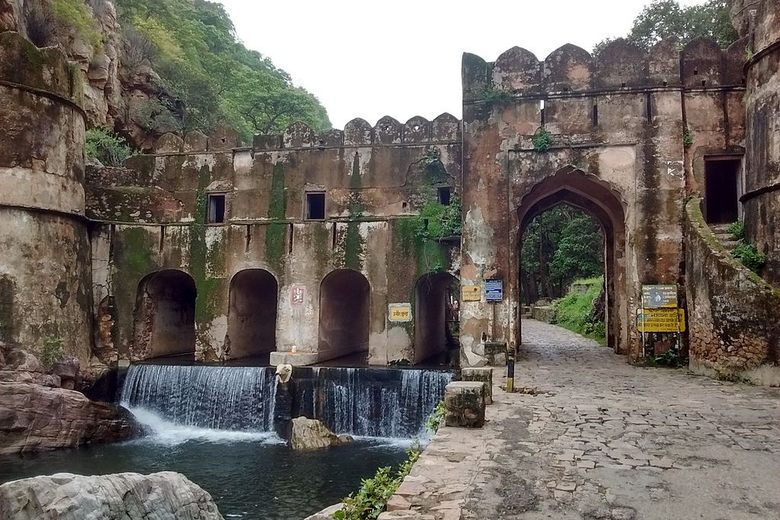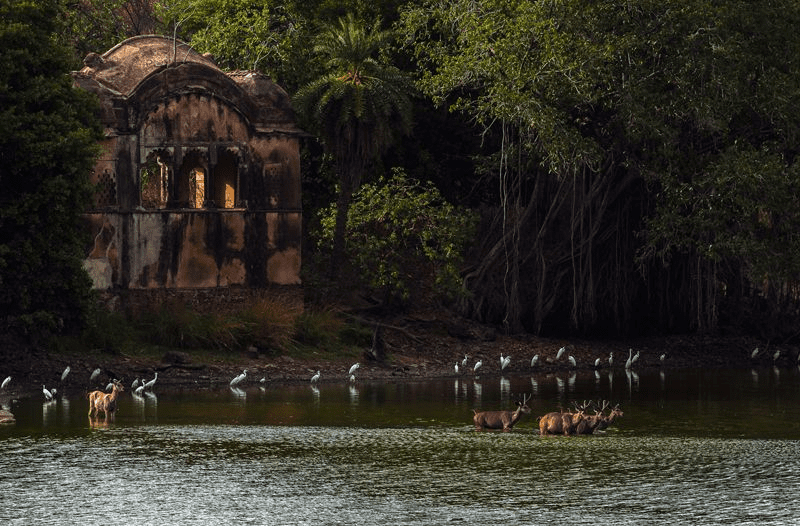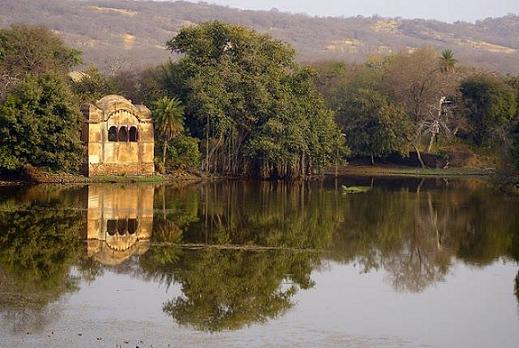BEST Palace to visit in Ranthambore
BEST palaces to visit in Ranthambore
Ranthambore National Park
The Ranthambore National Park derives its name from the Ranthambore Fort situated inside the park. This fort is one of the hill forts of Rajasthan recognized as UNESCO World Heritage Sites. Nestled within its premises is the Trinetra Ganesha Temple, a popular Hindu place of worship.
:max_bytes(150000):strip_icc()/tres-bengala-tigres-en-frente-de-turista-de-520373860-735d4cd8c3b147d98cce1f158d0eefab.jpg)
Ranthambore Fort
The noteworthy Ranthambore Fort was built by the Chauhan rulers in the 10th century. Due to its strategic location, it was ideal to keep the enemy at bay. The fort is also related to the historical legend of the royal women performing ‘jauhar’ (self-immolation) when the Muslim invader Alauddin Khilji laid siege on this fort in 1303. The fort is characterised by temples, tanks, massive gates and huge walls.

Trinetra Ganesh Temple
When we say “Pratham Ganesha ” in Hindu religion, it is believed to be the Trinetra Ganesha of Ranthambore. Located in Ranthambore fort of Rajasthan state of India, The Trinetra Ganesha Temple is the famous and oldest temple of Lord Ganesha in Rajasthan that comprises his whole family all together at one place. The temple is about 12 kms from Sawai Madhopur and is well established in Ranthambore fort. The temple is built with red Karauli stone and has been one of the most popular religious tourist attractions for ages. Lord Ganesha in Hindu Mythology is said to be the god of wish fulfillment.

Kachida Valley
Kachida Valley is located in close proximity to the outskirts of Ranthambore National Park in Rajasthan. This area consists of a large population of panthers, who migrated here to avoid conflicts with the Royal Bengal Tigers. It is also home to a sizable population of sloths, who are attracted towards the bee hives & large ant hills here. You can reach Kachida Valley only via a Jeep Safari. The surroundings are also extremely beautiful & great for some photography.

Surwal Lake
Surwal Lake, is a magnificent lake that will immediately carve a niche for itself in the hearts of nature lovers. The lively flora and the chirpy fauna, against the shimmering waters of the lake is a true splendor of nature. The place has the most surreal view during the time of sunrise, with the new morning rays lightning up the lake and warming our hearts. The lake is located some kilometers off Ranthambore and is worth every extra driven mile.

Jogi Mahal
Jogi Mahal is referred to as one of the places in Rajasthan where tigers used to rule. This is because of its close proximity to the hub of tigers – Ranthambore National Park. The Mahal is located at a distance of 500 meters from the Ranthambore Fort. It is considered as one of the oldest heritage buildings in exanse of Ranthambore. The Mahal made its way as a hunting resort for the royal families. The royal family used to spend some time at the Jogi Mahal in the course of their hunting expedition to the nearby forests of Ranthambore.

Raj Bagh Ruins
The Raj Bagh Ruins are situated between Padam Talo & Raj Bagh Talo in Ranthambore National Park. These ancient ruins are stone structures standing in the form of arches, palace outhouses, domes & steps. It lends an air of mystery & history to the surroundings. However, as impressive as these ruins are, they are surrounded by dense jungle, which often serve as the hideout for Royal Bengal Tigers. You can admire these stone ruins from a distance during your wildlife jeep safari in Ranthambore National Park.

Make a ENQUIRY
Trip Advisor Reviews

Read reviews |
Write review
Trip Advisor Reviews

Read reviews |
Write review
BEST Time to visit in ranthambore
Nestled in the heart of Rajasthan, India, Ranthambore National Park is a wildlife enthusiast’s paradise and a photographer’s dream come true. This iconic tiger reserve is not only known for its majestic striped inhabitants but also for its breathtaking landscapes and diverse flora and fauna. To truly appreciate the wonders of Ranthambore, it’s essential to plan your visit carefully. In this guide, we’ll explore the best time to visit Ranthambore to make the most of your wildlife adventure.
Winter Wonderland (October to March)
The months from October to March constitute the peak tourist season in Ranthambore. During this time, the weather is cool and pleasant, with daytime temperatures ranging from 20°C to 30°C (68°F to 86°F). This is undoubtedly the best time for wildlife enthusiasts and photographers to explore the park.
The advantages of visiting Ranthambore in winter are numerous. Firstly, the dry deciduous forests shed their leaves, improving visibility. Secondly, the water bodies within the park are the primary sources of hydration for the wildlife, making animal sightings near these areas more frequent and exciting. Lastly, the cooler temperatures are more comfortable for visitors, allowing them to explore the park without the discomfort of extreme heat.
Tiger Spotting Extravaganza (November to April)
If your primary goal is to spot the elusive Bengal tigers that call Ranthambore home, then the period from November to April is ideal. During these months, the dry vegetation and sparse foliage make it easier to spot these majestic creatures as they move about in search of water. The best chances of tiger sightings are in March and April when they frequently visit the park’s watering holes.
Birdwatcher’s Paradise (Winter Months)
Ranthambore isn’t just about tigers; it’s also a haven for birdwatchers. The winter months bring migratory birds to the region, making it a paradise for ornithologists and nature lovers. You can expect to see a wide variety of birds, including the Painted Stork, Grey-headed Fish Eagle, and the Indian Courser, among others.
Monsoon Magic (July to September)
While the monsoon season (July to September) may not be the typical time for visiting Ranthambore, it offers a unique and mesmerizing experience. The park comes alive with lush greenery, and the numerous water bodies overflow with water, creating a stunning contrast against the emerald backdrop. Though the park remains closed during July and August, it reopens in September, and this is a fantastic time for nature enthusiasts and photographers to capture the park’s dramatic transformation.
However, please note that during the monsoon, wildlife sightings can be a bit challenging due to the dense vegetation. Yet, this is a great opportunity for those who appreciate the beauty of nature and wish to experience the park in a different light.
Shoulder Seasons (April to June and September to October)
The months of April to June and September to October mark the shoulder seasons in Ranthambore. While these periods are less popular due to the extreme weather conditions, they offer unique experiences.
From April to June, the weather can be scorching, with temperatures often exceeding 40°C (104°F). The heat can make wildlife sightings less frequent, but it is a fantastic time for those seeking solitude and a true wilderness experience. You’ll have the park almost to yourself, and if you can withstand the heat, you may still have rewarding wildlife encounters.
In September and October, the park gradually transitions from the monsoon season to winter. The lush greenery begins to recede, and wildlife becomes more active. It’s a good time to visit if you want to avoid the crowds but still experience pleasant weather.
Choosing the best time to visit Ranthambore depends on your preferences and interests. Whether you’re a tiger enthusiast, a bird lover, or simply someone who wants to explore the beauty of nature, Ranthambore has something to offer year-round. Plan your visit wisely to make the most of this incredible wildlife sanctuary, and you’re sure to have an unforgettable experience in the heart of Rajasthan.


